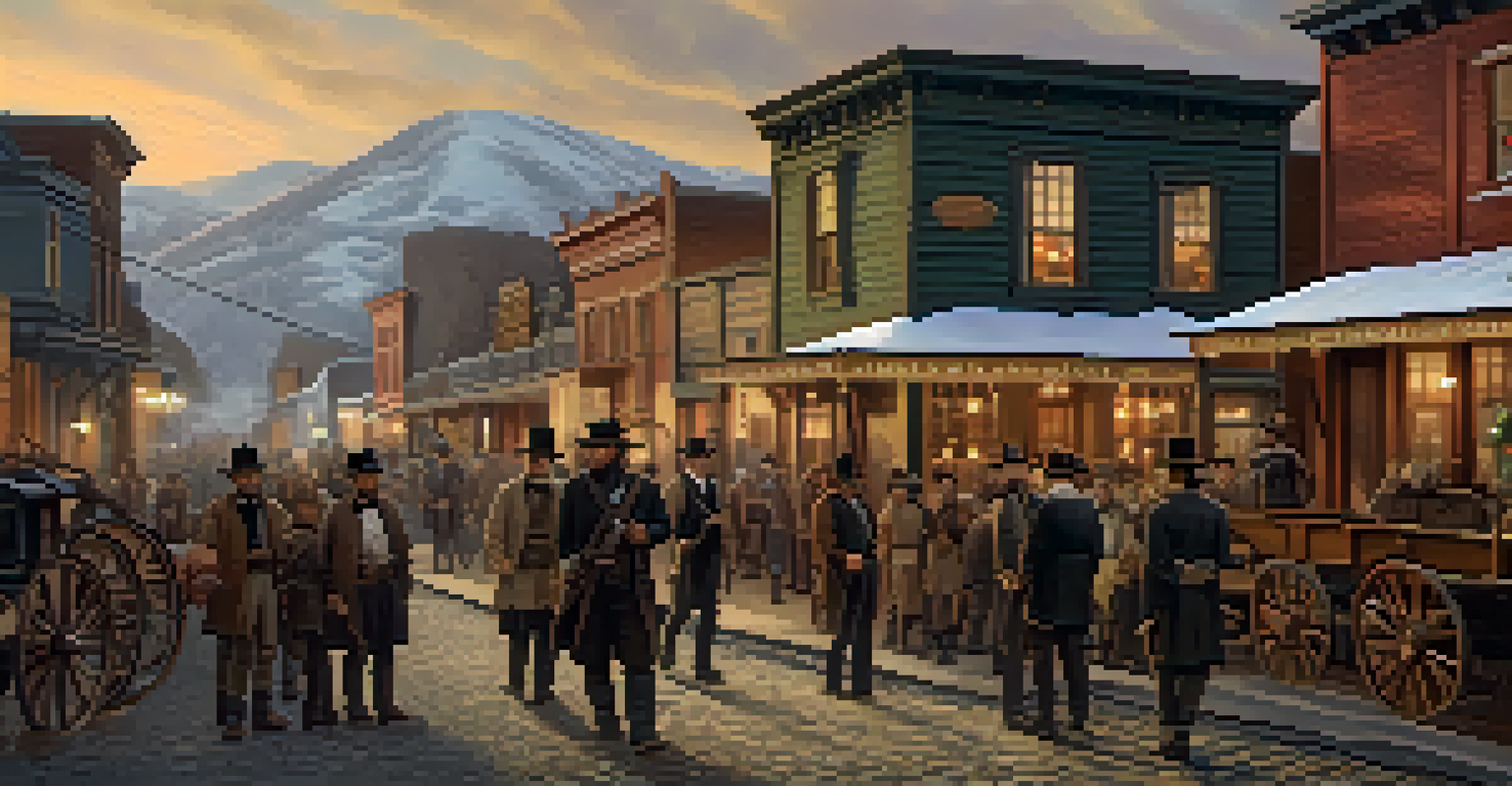Historic Landmarks in California: From Missions to Gold Rush

The Spanish Missions: Foundations of California History
The Spanish missions, established in the late 18th century, are vital to California's history. These outposts were designed to spread Christianity among the Native American population and lay the groundwork for European colonization. Each mission has its unique charm, from the ornate architecture of Mission San Juan Capistrano to the serene beauty of Mission Santa Barbara, showcasing the blend of cultures.
California is a place where the past meets the present, and the echoes of history resonate in every corner of its landscape.
Visiting these missions today offers a glimpse into the lives of early settlers and indigenous communities. Many missions, like Mission San Gabriel Arcángel, have been carefully preserved, allowing visitors to appreciate their historical significance. The quiet courtyards and lush gardens create a peaceful atmosphere, inviting reflection on the past.
Moreover, the missions played a crucial role in California's agricultural development. They introduced new farming techniques and crops, which transformed the landscape. As you explore these landmarks, you can trace the roots of California's diverse culture back to these early establishments.
Gold Rush Towns: Echoes of Opportunity and Struggle
The California Gold Rush of 1849 brought an influx of fortune seekers and shaped the state's identity. Towns like Nevada City and Grass Valley emerged as bustling hubs where dreams of wealth were chased and often dashed. Today, these towns are preserved as historic sites, inviting visitors to experience the excitement and challenges of that era.

Walking through the streets of these Gold Rush towns is like stepping back in time. The wooden storefronts, saloons, and old mining equipment tell stories of hardship and hope. Guided tours often recount tales of the colorful characters who sought their fortunes, making history come alive in a relatable way.
Spanish Missions Shaped California
Established in the late 18th century, the Spanish missions were crucial for spreading Christianity and influencing California's agricultural development.
Additionally, many of these towns now host festivals and events that celebrate their rich heritage. For instance, the Nevada City Victorian Christmas transforms the town into a festive wonderland, showcasing its unique history while providing a fun experience for families. These celebrations help keep the spirit of the Gold Rush alive.
California's Historic Capitals: Sacramento's Role
Sacramento, California's state capital, has a rich history that dates back to the Gold Rush. As a key trading post during that time, it attracted various entrepreneurs and settlers. The Historic Old Sacramento district is a preserved area that reflects this vibrant past, featuring wooden sidewalks and vintage storefronts that transport visitors back to the 1800s.
The preservation of our historic landmarks is essential to understanding and appreciating our shared heritage.
The California State Capitol building, with its grand architecture, stands as a symbol of governance and history. Inside, visitors can explore the museum that details California's political evolution. The juxtaposition of history and modern governance here illustrates how far the state has come since its Gold Rush days.
Moreover, Sacramento hosts numerous events and festivals that highlight its historic significance. From the annual Sacramento History Museum events to the Gold Rush Days, residents and visitors alike celebrate the city's rich tapestry of stories, making it a lively hub for history enthusiasts.
The Influence of Native American Heritage in Landmarks
California is home to a diverse array of Native American tribes, each with its own unique history and culture. Their influence can be seen in various landmarks throughout the state, from ancient rock art sites to modern museums. Understanding this heritage is essential for grasping the full narrative of California’s past.
One notable site is the Chumash Painted Cave State Historic Park, where visitors can see ancient rock paintings that tell stories of the indigenous peoples' connection to the land. These artworks provide insight into their beliefs, practices, and daily life, illustrating a rich cultural legacy that predates European settlement.
Gold Rush Towns Echo History
Towns like Nevada City and Grass Valley emerged during the Gold Rush, preserving stories of hope and hardship that continue to attract visitors today.
Additionally, many museums, such as the California Indian Museum and Cultural Center, aim to educate visitors about the ongoing impact of Native American history. Through exhibits, workshops, and storytelling, these institutions help preserve and honor the rich traditions and contributions of California's indigenous communities.
The Gold Rush Era: Historic Railroads and Their Legacies
The expansion of railroads during the Gold Rush was pivotal in connecting California to the rest of the country. Railroads facilitated the swift movement of people and goods, profoundly impacting the state’s development. Historic train stations, like the Southern Pacific Railroad Depot in Sacramento, offer a glimpse into this transformative period.
Today, many of these old train stations have been restored, serving as museums or cultural sites. They not only showcase vintage trains but also tell the stories of the people who traveled them. The experience of stepping onto a restored train evokes a sense of adventure, much like the pioneers who journeyed westward in search of opportunity.
Moreover, train rides through California's scenic landscapes offer a unique perspective on the state's beauty. For instance, the Napa Valley Wine Train provides a delightful excursion through vineyards with a historical twist, blending the past with modern enjoyment. This connection to history makes every journey memorable.
The Role of Historic Lighthouses Along the Coast
California's coastline is dotted with historic lighthouses that have guided sailors safely for generations. Structures like the Point Reyes Lighthouse and the Pigeon Point Light Station not only serve as navigational aids but also as symbols of resilience against the rugged coastal elements. Each lighthouse has its own unique design and story, steeped in maritime history.
Visiting these lighthouses often involves breathtaking views of the ocean and surrounding landscapes. Many of them feature visitor centers that provide educational exhibits about their history and the importance of maritime navigation. Standing at the edge of a cliff, looking out at the vast Pacific, one can appreciate the vital role these beacons played in ensuring safe passage for ships.
Historic Architecture Defines Identity
California's diverse architectural styles, from Spanish colonial to Victorian, reflect its rich cultural heritage and ongoing efforts to preserve these historic sites.
Additionally, some lighthouses offer guided tours, allowing visitors to climb to the top for panoramic views. The experience of standing at the light's apex, with the wind in your hair and waves crashing below, creates a visceral connection to the maritime history of California. It’s a reminder of the courage and dedication of those who maintained these lights.
The Impact of Historic Architecture on California's Identity
California's historic architecture is a reflection of its diverse cultural influences, from Spanish colonial to Victorian styles. Iconic buildings, such as the Hearst Castle and the Mission San Diego de Alcalá, showcase the artistic and architectural innovations that have shaped the state. Each structure tells a story, revealing the values and aspirations of the people who built them.
Exploring these architectural wonders provides insight into California's evolution. For example, the ornate designs of the Victorian homes in San Francisco, known as the 'Painted Ladies,' illustrate the prosperity of the Gold Rush era. As visitors admire these stunning homes, they can appreciate the craftsmanship and attention to detail that went into their construction.

Moreover, preserving this architectural heritage is crucial for future generations. Many organizations work tirelessly to restore and protect these historic buildings, ensuring that their stories endure. By visiting and supporting these sites, we contribute to the ongoing appreciation of California's rich architectural legacy.